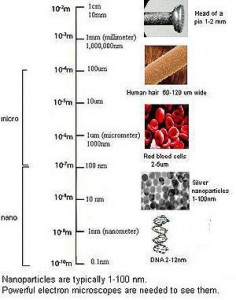23
Jul
Nanoparticles in Athletic Wear: Don’t Sweat It?
(Beyond Pesticides, July 23, 2013) When shopping for sportswear nowadays, you might notice the stickers or tags on some clothing items touting the apparel as “antimicrobial.” What’s not mentioned on those tags, however, is the point that these antimicrobials, often titanium dioxide or silver nanoparticles (nanosilver), are largely untested, and recent studies are revealing that these substances could seep into a person’s sweat and end up being absorbed through one’s skin. Lead researcher of the study published in Environmental Science and Technology, Natalie von Gotz, Ph.D,, found that some pieces of clothing released significant amounts of nanosilver.
 Manufacturers are adding nanoparticles to clothing in order to tout their ability to block UV rays (titanium dioxide) or prevent mold and smells (nanosilver) on clothing. However, the long-term impacts of this new technology to human health and the environment are still unknown. There are concerns about the ability of nanomaterial to travel through the human body and damage brain, liver, stomach, testes and other organs, as well as pass from mother to fetus, according to a recent Natural Resources Defense Council (NRDC) report. Laundering these products ultimately washes them into our environment because sewage treatment plants are not set up to filter out the microscopic particles. Beyond Pesticides has recently documented the ability of silver nanoparticles to disrupt ecosystems, cause deformities in fish, and harm earthworms by suppressing their immune system.
Manufacturers are adding nanoparticles to clothing in order to tout their ability to block UV rays (titanium dioxide) or prevent mold and smells (nanosilver) on clothing. However, the long-term impacts of this new technology to human health and the environment are still unknown. There are concerns about the ability of nanomaterial to travel through the human body and damage brain, liver, stomach, testes and other organs, as well as pass from mother to fetus, according to a recent Natural Resources Defense Council (NRDC) report. Laundering these products ultimately washes them into our environment because sewage treatment plants are not set up to filter out the microscopic particles. Beyond Pesticides has recently documented the ability of silver nanoparticles to disrupt ecosystems, cause deformities in fish, and harm earthworms by suppressing their immune system.
To estimate the risk of exposure from nanoparticles seeping through impregnated clothing, researchers simulated the wear-and-tear that occurs during normal physical activity. Samples were placed into plastic bottles containing acrylic balls and artificial sweat (a mixture of salt and organic compounds used to mimic human sweat), and then agitated in a washing machine for 30 minutes. The researchers then measured the amount and size of the nanoparticles that seeped into the artificial sweat. Exposure estimates for normal physical activity such as cycling were extrapolated based on this information, as well as a person’s weight, gender and the size of the apparel.
Researchers found that a 170 lb male and a 136 lb female could be exposed to up to 1.3 mg/day and .6 mg/day of nanosilver respectively. Comparatively, those taking supplements that contain nanosilver are at most exposed to .5mg/day. For titanium dioxide nanoparticles, the researchers concluded that exposure levels were negligible compared to other sources of exposure such as sunscreen, which can amount to 1000mg from a single application.
The researchers did not test the exposure levels expected in children, as most sportswear is marketed to adults. However, NRDC is currently engaged in a lawsuit against the U.S. Environmental Protection Agency (EPA) over the conditional registration of nanosilver in textile products. In arguments over whether EPA lawfully granted conditional registration to the nanosilver pesticide product “HeiQ AGS-20,” NRDC is challenging EPA’s risk assessment for infants and children, arguing that the agency erred by assuming in its risk assessment that 3-year-olds would be the most vulnerable consumers. Instead, NRDC attorney Catherine Rahm maintains that, “Infants are more likely than any other subgroup to chew on fabrics that could contain this pesticide.” NRDC contends that EPA’s assessment is flawed in distinguishing the chewing action between infants and toddlers, arguing that infants are also at high risk from oral exposures.
Beyond Pesticides encourages consumers to avoid purchasing pesticide-impregnated clothing due to the potential risks associated with wearing these garments. Just as the size and chemical characteristics of manufactured nanoparticles can give them unique properties, these same properties —tiny size, vastly increased surface area to volume ratio, high reactivity— can also create unique and unpredictable human health and environmental risks. In the past, Beyond Pesticides has worked against clothing impregnated with the likely carcinogen and synthetic pyrethroid permethrin.
For more information on the potential hazards associated with untested nanotechnology, see Beyond Pesticides Nanosilver program page.
All unattributed positions and opinions in this piece are those of Beyond Pesticides.
Source: Chemical and Engineering News










